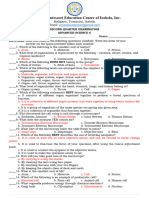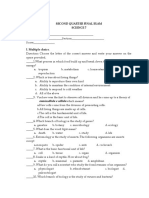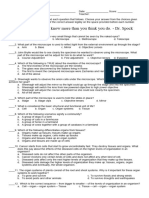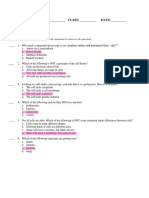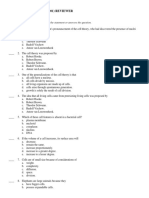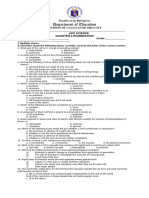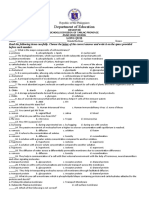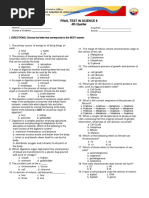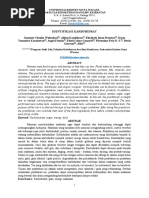0 ratings0% found this document useful (0 votes)
14 viewsEls 2ND
Els 2ND
Uploaded by
Reymark Lattao Malayao1. This document appears to be a quiz on Earth and Life Science for a Grade and Strand at Peñablanca East National High School in Cagayan, Philippines.
2. It consists of 47 multiple choice questions testing knowledge of topics including cell biology, anatomy, reproduction, symbiosis, biochemistry and genetics.
3. The questions cover structures and functions of plant and animal cells, characteristics of living things, scientific branches that study different biological areas, and components of DNA, RNA and protein synthesis.
Copyright:
© All Rights Reserved
Available Formats
Download as DOCX, PDF, TXT or read online from Scribd
Els 2ND
Els 2ND
Uploaded by
Reymark Lattao Malayao0 ratings0% found this document useful (0 votes)
14 views3 pages1. This document appears to be a quiz on Earth and Life Science for a Grade and Strand at Peñablanca East National High School in Cagayan, Philippines.
2. It consists of 47 multiple choice questions testing knowledge of topics including cell biology, anatomy, reproduction, symbiosis, biochemistry and genetics.
3. The questions cover structures and functions of plant and animal cells, characteristics of living things, scientific branches that study different biological areas, and components of DNA, RNA and protein synthesis.
Original Title
ELS 2ND
Copyright
© © All Rights Reserved
Available Formats
DOCX, PDF, TXT or read online from Scribd
Share this document
Did you find this document useful?
Is this content inappropriate?
1. This document appears to be a quiz on Earth and Life Science for a Grade and Strand at Peñablanca East National High School in Cagayan, Philippines.
2. It consists of 47 multiple choice questions testing knowledge of topics including cell biology, anatomy, reproduction, symbiosis, biochemistry and genetics.
3. The questions cover structures and functions of plant and animal cells, characteristics of living things, scientific branches that study different biological areas, and components of DNA, RNA and protein synthesis.
Copyright:
© All Rights Reserved
Available Formats
Download as DOCX, PDF, TXT or read online from Scribd
Download as docx, pdf, or txt
0 ratings0% found this document useful (0 votes)
14 views3 pagesEls 2ND
Els 2ND
Uploaded by
Reymark Lattao Malayao1. This document appears to be a quiz on Earth and Life Science for a Grade and Strand at Peñablanca East National High School in Cagayan, Philippines.
2. It consists of 47 multiple choice questions testing knowledge of topics including cell biology, anatomy, reproduction, symbiosis, biochemistry and genetics.
3. The questions cover structures and functions of plant and animal cells, characteristics of living things, scientific branches that study different biological areas, and components of DNA, RNA and protein synthesis.
Copyright:
© All Rights Reserved
Available Formats
Download as DOCX, PDF, TXT or read online from Scribd
Download as docx, pdf, or txt
You are on page 1of 3
Republic of the Philippines
Department of Education
Schools Division of Cagayan
Peñablanca East National High School
Manga Peñablanca, Cagayan
Second Quarter Examination- Earth and Life Science
Name:_____________________________________________Score:______________
Grade & Strand:_____________________________________Date:__________________
Multiple Choice.
Directions: Write the letter of the correct answer on the space before each number. Your answer must
be in Capital Letter. NO ERASURES!
____1. Which cell group does not possess a true nucleus?
a. Prokaryotes b. Eukaryotes c. Plants d. Animals
____2. Which of the following is a eukaryote?
a. Bacteria b. Virus c. Archaea d. Sperm
____3. Which of the following is found in all prokaryotic cells but only in some eukaryotic
cells?
a. Cell membrane b. Cell wall c. Mitochondria d. Ribosome
____4. Where in the cell are protein synthesized?
a. Mitochondria b. Vacuole c. Ribosomes d. Nucleus
____5. Where do the majority of metabolic reactions take place?
a. Cytoplasm b. Nucleus c. Cell membrane d. Ribosomes
____6. The food producer within the plant cell uses energy from the sun and converts carbon
dioxide and water into sugars. This sub-cellular structure is called
a. vacuole b. Mitochondria c. Chloroplast d. nucleus
____7. The thick rigid layer that surrounds plant cells and provides support and structure is
called
a. nucleus. b. mitochondria. c. cell wall. d. Chloroplast
____8. Which of the following is/are characteristics of living organisms?
a. Organized structure c. Maintenance of homeostasis
b. Growth and reproduction d. A, B and C
____9.What do we call the maintenance of internal conditions of an organism within a certain
boundary range?
a. Evolution b. Homeostasis c. Adaptation d. Metabolism
____10.What branch of Biology deals with the study of cells?
a. Histology b.Cytology c. Physiology d. Anatomy
____11.What branch of Biology deals with the study of tissues?
a. Histology b.Cytology c. Physiology d. Anatomy
____12.What branch of Biology deals with the study of interactions and relationships within an
ecosystem?
a. Histology b.Cytology c. Physiology d. Ecology
____13.What characteristic of living things is necessary for producing other living things of their
kind?
a. growth b. metabolism c. abiogenesis d. big bang theory
____14. Which of the following originated from explosion of hot rotating ball of gas and
eventually life was formed from the chemical evolution of different compounds present
in the primitive earth?
a. cosmozoic b. spontaneous c. big bang d. philosophical
____15. Which of the following is the smallest particle of matter non-divisible by chemical
means?
a. atoms b. protons c. neutrons d. electrons
____16. Which of the following is the element abundant in living things?
a. oxygen b. carbon c. hydrogen d. nitrogen
____17. Which type of cell does not contain membrane-bound organelles?
a. prokaryote b. eukaryote c. bacteria d. algae
____18. Which type of cell has ribosomes?
a. prokaryote c. eukaryote
b. both prokaryote and eukaryote d. none of the above
____19. Which part of the cell is responsible for controlling the activities of the other parts of the
cell?
a. vacuole b. nucleus c. mitochondria d. cytoplasm
____20. Which part of the cell is responsible for breaking down used organelles and essentially
‘’digesting’’ substances?
a. rough ER b. soft ER c. lysosome d. chloroplast
____21. Which of the following is considered as the science of balance?
a. Histology b. cytology c. homeostasis d. Genetics
____22. Which of the female reproductive system is described as hollow, muscular, and
pear-shaped organ?
a. fallopian tube b. cervix c. uterus d. ostium
____23. Which of the female reproductive system are the finger-like structure around the
opening that trap egg as it leaves the ovary?
a. fallopian tube b. cervix c. uterus d. fimbria
____24. What is the hormone necessary for the development of male reproductive system?
a. serotonin b. testosterone c. estrogen d. progesterone
____25. What is the hormone necessary for the development of female reproductive system?
a. serotonin b. testosterone c. estrogen d. oxytocin
_____26. Which of the following organelle is in the mid piece of a sperm cell?
a. nucleus b. mitochondria c. centrioles d. cytoplasm
____27. Which of the following is necessary for movement of a cell?
a. nucleus b. mitochondria c. centrioles d. flagella
____28. What part of the male reproductive system are matured sperm cell stored?
a. scrotum b. epididymis c. ureter d. flagellum
____29. What type of reproduction occurs in highest form of organisms like human?
a. sexual b. asexual c. fission d. fusion
____30. What type of reproduction occurs on worms?
a. sexual b. asexual c. hermaphroditism d. fusion
____31. Which of the following type of symbiosis shows that organisms benefit together?
a. mutualism b. commensalism c. paratism d. predation
____32. What type of symbiotic relationship shows one organism benefit and the other one is
harmed?
a. mutualism b. commensalism c. paratism d. predation
____33. What type of symbiotic relationship shows that one organism benefits and the other is
not helped or harmed?
a. mutualism b. commensalism c. paratism d. predation
____34. What type of symbiosis is involved when a tick lives on a dog’s body?
a. mutualism b. commensalism c. paratism d. predation
____35. What type of symbiosis is involved when a tapeworm lives in student’s intestines?
a. mutualism b. commensalism c. paratism d. predation
____36. What type of symbiosis is involved when a hermit crab carries sea anemone on its back?
a. mutualism b. commensalism c. paratism d. predation
____37. What type of symbiosis is involved when ants are protecting the acacia tree and tree
provides food for the ants?
a. mutualism b. commensalism c. paratism d. predation
____38. Which of the following provides energy to nucleotides?
a. ATP b. sugar c. ribose d. deoxyribose
____39. Which of the following is the sugar for RNA?
a. deoxyribose b. glucose c. ribose d. fructose
____40. Which of the following is the sugar for DNA?
a. deoxyribose b. glucose c. ribose d. fructose
____41. Which of the following is not element found in carbohydrates?
a. carbon b. hydrogen c. oxygen d. nitrogen
____42. What is produced when a glucose and fructose is combined?
a. sucrose b. maltose c. ribose d. deoxyribose
____43. What is produced when a glucose is combined with another glucose?
a. sucrose b. maltose c. ribose d.
deoxyribose
____44. What enzyme breaks the hydrogen of nucleotides?
a. dna ligase b. dna polymerase c. helicase d. purines
____43. What enzyme synthesize the individual nucleotides to produce new DNA?
a. dna ligase b. dna polymerase c. helicase d. purines
____44. What enzyme binds the fragments of DNA to one another?
a. dna ligase b. dna polymerase c. helicase d. purines
____45. Which of the following is not included in the part of nucleotides in DNA?
a. translation b. pentose sugar c. phosphate d. base pair
____46. What type of RNA carries information from the DNA to the cytoplasm?
a. messenger RNA b. ribosomal RNA c.transfer RNA
____47. What type of RNA composes of ribosomes that contains enzymes needed for
protein synthesis?
a. messenger RNA b. ribosomal RNA c.transfer RNA
_____48. What device is used by James Watson and Francis Crick in checking and
evaluating the structure of DNA?
a. x-ray crystallography b. microscope c. telescope d. magnifying lens
_____49. What type of RNA carries amino acids to ribosomes?
a. messenger RNA b. ribosomal RNA c.transfer RNA
_____50. What nitrogenous base is replaced by thymine in RNA?
a. adenine b. guanine c. cytosine d. uracil
‘’THE BEST WAY TO PREDICT YOUR FUTURE IS TO CREATE IT’’
Prepared by: Checked by:
Reymark L. Malayao Rowena Venesa C. Pagalilauan
Shs Teacher Head Teacher III
Noted by:
Teodolfo C. Lopez
Principal I
You might also like
- Year 1 Semester 1 Study Guide (Medical School)Document51 pagesYear 1 Semester 1 Study Guide (Medical School)Phillip CharlesNo ratings yet
- Second QuarterDocument3 pagesSecond QuarterShaikha Rose A. CacabilosNo ratings yet
- UntitledDocument3 pagesUntitledEDWIN DUMOPOYNo ratings yet
- Instruction: Read and Understand Each Question That Follows. Choose Your Answer From The Choices GivenDocument3 pagesInstruction: Read and Understand Each Question That Follows. Choose Your Answer From The Choices GivenEDWIN DUMOPOYNo ratings yet
- UntitledDocument3 pagesUntitledEDWIN DUMOPOYNo ratings yet
- Science-7-ExamDocument10 pagesScience-7-ExamCarmela Jean GuanzonNo ratings yet
- 3rd Periodic Test Science 10Document2 pages3rd Periodic Test Science 10Anonymous xagGSIdNo ratings yet
- GENERAL BIOLOGY 1 (REMEDIAL)Document3 pagesGENERAL BIOLOGY 1 (REMEDIAL)Tabayoyong, Joshua V.No ratings yet
- Gen Physics 1 ExamDocument8 pagesGen Physics 1 ExamArvinNo ratings yet
- UntitledDocument2 pagesUntitledEDWIN DUMOPOYNo ratings yet
- Questionnaire in Science 2Document4 pagesQuestionnaire in Science 2Rebecca CaponongNo ratings yet
- Name: Grade & Section: TeacherDocument4 pagesName: Grade & Section: TeacherMara LabanderoNo ratings yet
- EARTH AND LIFE SCIENCE FINAL QUIZDocument2 pagesEARTH AND LIFE SCIENCE FINAL QUIZTabayoyong, Joshua V.No ratings yet
- Pre Test BiotechDocument3 pagesPre Test BiotechMichaelAbdonDomingoFavoNo ratings yet
- Biology Test Cell StructureDocument7 pagesBiology Test Cell Structuredee.aira295550% (2)
- Second Quarter Test Science 7Document4 pagesSecond Quarter Test Science 7Vhinajoana JavierNo ratings yet
- Grade 7STE Science 2nd QuarterDocument7 pagesGrade 7STE Science 2nd Quarterjovdoctolero15No ratings yet
- Second Quarter Test Science 7Document5 pagesSecond Quarter Test Science 7QUEENIE BUTALIDNo ratings yet
- Second Periodical Test in Science 7Document3 pagesSecond Periodical Test in Science 7tolis67% (3)
- Benli National High School 2 Periodic Test in Science: Grade 7Document3 pagesBenli National High School 2 Periodic Test in Science: Grade 7Ardian de GuzmanNo ratings yet
- 2nd Periodic Exam2014Document7 pages2nd Periodic Exam2014cattleya abelloNo ratings yet
- Second Quarter Test Science 7Document5 pagesSecond Quarter Test Science 7Ryan Spencer MiguelNo ratings yet
- Second Periodical ExaminationDocument4 pagesSecond Periodical ExaminationKhalilNo ratings yet
- Diagnostic Test Gen. Bio. 1Document5 pagesDiagnostic Test Gen. Bio. 1Stephen AbadinasNo ratings yet
- Kami Export - MARC LOUIS - Biology Test Cell StructureDocument6 pagesKami Export - MARC LOUIS - Biology Test Cell StructureMarc LouisNo ratings yet
- 2ND Finals EARTHSCIDocument3 pages2ND Finals EARTHSCIIris LeuterioNo ratings yet
- 2q Els ReviseDocument2 pages2q Els ReviseCarmelito Nuque JrNo ratings yet
- 4th PT FINALscience8Document5 pages4th PT FINALscience8Berith Grace Magcalas-GallardoNo ratings yet
- Chapter 7 Test Bank: Multiple ChoiceDocument22 pagesChapter 7 Test Bank: Multiple ChoicePayal100% (1)
- Semi QuarterDocument3 pagesSemi QuarterShaikha Rose A. CacabilosNo ratings yet
- General Biology 1 (BIO01) Reviewer 2017Document30 pagesGeneral Biology 1 (BIO01) Reviewer 2017Adonis AdornadoNo ratings yet
- Bio 2Document7 pagesBio 2Lady Jane BenignoNo ratings yet
- Life Science Midterm Review 2012Document17 pagesLife Science Midterm Review 2012AndoingNo ratings yet
- 2nd Q ExamDocument4 pages2nd Q ExamEden GorraNo ratings yet
- HuntersWoodsPH Science Reviewer Set ADocument21 pagesHuntersWoodsPH Science Reviewer Set AScc Balayong ESNo ratings yet
- First Quarter Examination - General Biology 1Document8 pagesFirst Quarter Examination - General Biology 1hayslorsNo ratings yet
- Biology 1 ExaminationDocument3 pagesBiology 1 ExaminationMa Es Tro100% (5)
- Sta. Cruz National High SchoolDocument3 pagesSta. Cruz National High SchoolGrace TiongsonNo ratings yet
- LIFE SCIENCE SECOND QUARTER EXAMDocument3 pagesLIFE SCIENCE SECOND QUARTER EXAMVinz AlilingNo ratings yet
- 2nd Quarter-Science 7 2018Document4 pages2nd Quarter-Science 7 2018Ninel Jean Cantera BunielNo ratings yet
- Science 8 Final Summative TestDocument2 pagesScience 8 Final Summative TestEnrick PestilosNo ratings yet
- QUARTER 2 Third-summative-test-2nd-qrtr-M5M6-SCIENCE 7Document2 pagesQUARTER 2 Third-summative-test-2nd-qrtr-M5M6-SCIENCE 7TEOFILA NOLASCO100% (1)
- Department of Education: Republic of The PhilippinesDocument2 pagesDepartment of Education: Republic of The PhilippinesGlaiza Dalayoan FloresNo ratings yet
- Long QuizDocument3 pagesLong Quizfernandezkhryztal30No ratings yet
- Biology 7 - Mock Comp - Global - 1Document9 pagesBiology 7 - Mock Comp - Global - 1f2tsd8wj64No ratings yet
- 2ndmontly Science7Document3 pages2ndmontly Science7angge21No ratings yet
- First Quarter Exam Bio 094647Document5 pagesFirst Quarter Exam Bio 094647Maria Teresa OfiasaNo ratings yet
- Q 1: Match The Followings: (16 Marks) : B. CellDocument4 pagesQ 1: Match The Followings: (16 Marks) : B. CellAram HakimNo ratings yet
- 3rd PrelimG10Document4 pages3rd PrelimG10Eunice CorreaNo ratings yet
- Biology Quizbee ReviewerDocument4 pagesBiology Quizbee Reviewerkim natividadNo ratings yet
- Science 7Document3 pagesScience 7JL IndianoNo ratings yet
- Exam 4th Grade 8Document4 pagesExam 4th Grade 8CharizNo ratings yet
- Final Exam gr.8Document3 pagesFinal Exam gr.8tired100% (1)
- Final ExamDocument8 pagesFinal Examapi-485110415No ratings yet
- Revision - CH 5-The Fundamental Unit of Life - Abhinav ChavanDocument4 pagesRevision - CH 5-The Fundamental Unit of Life - Abhinav Chavanabhinavchavan3108No ratings yet
- Cell Organelles Quiz 2Document3 pagesCell Organelles Quiz 2ellie.foxhoven26No ratings yet
- Biology I: Multiple Choice Questions 20 Items Name: - SchoolDocument3 pagesBiology I: Multiple Choice Questions 20 Items Name: - SchoolEJ RaveloNo ratings yet
- CH 7 Part I TESTDocument7 pagesCH 7 Part I TESTlshawNo ratings yet
- Pre-Test Science 7 - BiologyDocument5 pagesPre-Test Science 7 - BiologyMark Wendel Murillo0% (1)
- Biological Science Let QuestionairesDocument126 pagesBiological Science Let Questionairesnicoleannsumayan77No ratings yet
- High School Biology: Questions & Explanations for Organismal BiologyFrom EverandHigh School Biology: Questions & Explanations for Organismal BiologyNo ratings yet
- 2-Glycolysis 2014 Lecture - MDDocument29 pages2-Glycolysis 2014 Lecture - MDIbrahim BarhamNo ratings yet
- Biology For Prelims (Sscstudy - Com)Document385 pagesBiology For Prelims (Sscstudy - Com)Abhisar KhokharNo ratings yet
- 2.ultrastructure of Bacterial Cell 10.2.2016Document98 pages2.ultrastructure of Bacterial Cell 10.2.2016Odey BeekNo ratings yet
- A Lab Report On Effect of Enzymes in Digestion.Document9 pagesA Lab Report On Effect of Enzymes in Digestion.Tazneen Hossain TaniNo ratings yet
- Cell - The Fundamental Unit of LifeDocument20 pagesCell - The Fundamental Unit of LifeKavya GoelNo ratings yet
- Metabolism of Phospholipids: Gandham - Rajeev Email:gandhamrajeev33@gmaDocument32 pagesMetabolism of Phospholipids: Gandham - Rajeev Email:gandhamrajeev33@gmaOnSolomonNo ratings yet
- Assignment No. 1 - LADMER SystemDocument12 pagesAssignment No. 1 - LADMER SystemDana FuentesNo ratings yet
- Specialization - I: M.SC., Clinical Nutrition and Dietetics Semester - 1 Fn1.1: Nutrition Through Life CycleDocument47 pagesSpecialization - I: M.SC., Clinical Nutrition and Dietetics Semester - 1 Fn1.1: Nutrition Through Life CycleAryan RaykarNo ratings yet
- Biomolecules Game Changer 3 DecDocument121 pagesBiomolecules Game Changer 3 DecpiyaliNo ratings yet
- Module 6 RationaleDocument1 pageModule 6 RationaleG INo ratings yet
- PHD Thesis PhotosynthesisDocument7 pagesPHD Thesis Photosynthesisbsr3rf42100% (3)
- Synergistic Biodegradation of Aromatic - Aliphatic Copolyester Plastic by A Marine MicrobialDocument13 pagesSynergistic Biodegradation of Aromatic - Aliphatic Copolyester Plastic by A Marine MicrobialMurimi MuchinaNo ratings yet
- Native Barcoding Genomic Dna NBE - 9065 - v109 - revAC - 14aug2019 MinionDocument29 pagesNative Barcoding Genomic Dna NBE - 9065 - v109 - revAC - 14aug2019 MinionErikk DangNo ratings yet
- Test Bank For Genetics Analysis and Principles 6th by Brooker All Chapter Instant DownloadDocument12 pagesTest Bank For Genetics Analysis and Principles 6th by Brooker All Chapter Instant DownloadbriotekatilaNo ratings yet
- BIOL 215 - CWRU Final Exam Learning GoalsDocument32 pagesBIOL 215 - CWRU Final Exam Learning GoalsKesharaSSNo ratings yet
- Methods For The Study of Deep-Sea Sediments, Their Functíoning and BiodíversityDocument5 pagesMethods For The Study of Deep-Sea Sediments, Their Functíoning and BiodíversityDavid MasallesNo ratings yet
- Norme SangeDocument2 pagesNorme SangePS NINo ratings yet
- 13.1 Chromosomal Abberation StructuralDocument28 pages13.1 Chromosomal Abberation StructuralDhungana Surya RdNo ratings yet
- Fucoidan-New Principle Prevention and Treatment of DiabetesDocument7 pagesFucoidan-New Principle Prevention and Treatment of DiabetesSabrina JonesNo ratings yet
- Art Moringa Ingles EspañolDocument23 pagesArt Moringa Ingles EspañolMía Fernanda Guzman VásquezNo ratings yet
- Cambridge Assessment International Education: Biology 9700/21 May/June 2018Document14 pagesCambridge Assessment International Education: Biology 9700/21 May/June 2018Ali RanaNo ratings yet
- 9 Th. Lec. Lewis Blood Group SystemDocument11 pages9 Th. Lec. Lewis Blood Group Systemda202263357026No ratings yet
- C. Elegans Genetic PortaitDocument26 pagesC. Elegans Genetic PortaitbelovedaffectionNo ratings yet
- Red Blood Cell and Platelet PreservationDocument27 pagesRed Blood Cell and Platelet PreservationiamdlawNo ratings yet
- Pharmacodynamics 1Document49 pagesPharmacodynamics 1Anisa WahyuniartiNo ratings yet
- Identifikasi KarbohidratDocument11 pagesIdentifikasi KarbohidratJeannete Claudia WulandariNo ratings yet
- Kami Export - D1.2 Protein SynthesisDocument6 pagesKami Export - D1.2 Protein Synthesislbooks06No ratings yet
- TRUENESS genbio1_Transport MechanismsDocument44 pagesTRUENESS genbio1_Transport MechanismsFLORAMAE MONTERDENo ratings yet
- User Manual: Macherey-NagelDocument34 pagesUser Manual: Macherey-NagelBatuli MwaijandeNo ratings yet

